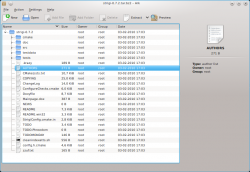Ark/de: Difference between revisions
Appearance
Neverendingo (talk | contribs) Created page with '==Dateien entpacken==' |
Neverendingo (talk | contribs) Created page with 'Diesem Fall werden die meisten Leute zuerst begegnen. * Mit einer einzigen markierten Datei werden Sie gefragt, ob Sie diese eine Datei oder alle Dateien entpacken wollen. * Das ...' |
||
| Line 22: | Line 22: | ||
==Dateien entpacken== | ==Dateien entpacken== | ||
Diesem Fall werden die meisten Leute zuerst begegnen. | |||
* | * Mit einer einzigen markierten Datei werden Sie gefragt, ob Sie diese eine Datei oder alle Dateien entpacken wollen. | ||
* | * Das Archiv bleibt intakt und die gewählte Datei wird in ein Verzeichnis Ihrer Wahl gespeichert. | ||
The way that extracting works has changed in recent versions, so may feel strange to someone recently working with KDE3. There are two ways that you can control the Extraction. | The way that extracting works has changed in recent versions, so may feel strange to someone recently working with KDE3. There are two ways that you can control the Extraction. | ||
Revision as of 16:26, 10 September 2010
Template:I18n/Language Navigation Bar
 |
Ark ist ein Programm zum Verwalten von Dateiarchiven |
Eigenschaften
Ark ermöglicht es Ihnen,
- ein komprimiertes Archiv zu erstellen
- den Inhalt einer Archivdatei anzuzeigen
- den Inhalt eines Archivs in ein Verzeichnis Ihrer Wahl zu extrahieren
Es kommt mit vielen Formaten zurecht, einschließlich tar, gzip, bzip2, zip, rar und 7z.
Ein Archiv erstellen
- Dateien mit dem Aktionen-Menü zu einem Archiv hinzugefügt werden.
- Alternativ können Datein von einem Konqueror- oder Dolphin-Fenster in das Ark-Hauptfenster gezogen werden.
- Im Aktionen-Menü ist auch der Punkt , um ein ganzes Verzeichnis in das Archiv zu ziehen.
- Dateien können jederzeit einem gespeicherten Archiv hinzugefügt werden.
Dateien entpacken
Diesem Fall werden die meisten Leute zuerst begegnen.
- Mit einer einzigen markierten Datei werden Sie gefragt, ob Sie diese eine Datei oder alle Dateien entpacken wollen.
- Das Archiv bleibt intakt und die gewählte Datei wird in ein Verzeichnis Ihrer Wahl gespeichert.
The way that extracting works has changed in recent versions, so may feel strange to someone recently working with KDE3. There are two ways that you can control the Extraction.
- When viewing the archive within Ark, use button on the toolbar or Ctrl-E . This gives you a navigable tree where you can select your destination.
- When viewing the archive in Dolphin, right click on it and you will get three options:
- Extract here, Autodetect Subfolder
- Extract to....
- Extract here.
- The second option works the same as Ctrl-E within Ark.
- The third option does exactly what it says - if no folder is defined within the archive, all the extracted files will end up in the current directory. If the archive does contain a folder, then a folder will be created under the current folder, and all files extracted into that folder.
- The first option is similar to the third one, but when no folder is defined within the archive, Ark will create one, then all files extracted into that folder. If, for instance, your archive is called Patterns.zip and it contains all the designs, you would end up with a structure like ~/Patterns/design1 etc.
Working with Files
- Very often an archive will contain a README or some other instruction file. It is often useful to be able to preview that file before starting work with the archive. Double click any file in archive will open preview.
- It may be that one file in an archive becomes irrelevant. The file can be deleted within the archive.
- In the KDE3 version it is possible to any suitable application
- It is also possible, in the KDE3 version, to an application.
(These two features are not available in the KDE SC 4 version yet)
